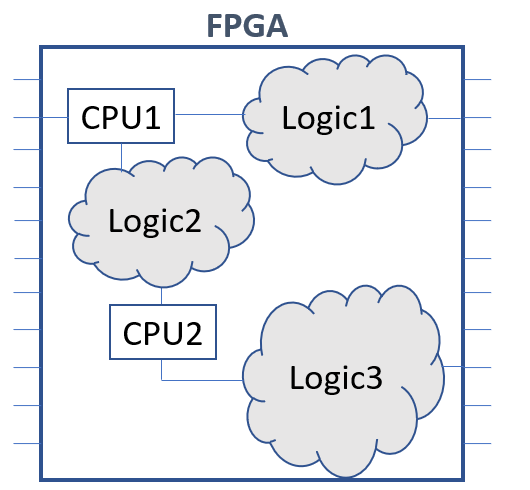This website uses cookies so that we can provide you with the best user experience possible. Cookie information is stored in your browser and performs functions such as recognising you when you return to our website and helping our team to understand which sections of the website you find most interesting and useful.
FPGA vs. CPU – What is the difference
04/02/2019, hardwarebee
So, you need to design a digital circuit, but you are not sure whether to choose FPGA vs CPU. In some cases, you can implement the exact same functionality using a CPU or an FPGA but not at the same cost and speed.
This article will help you understand the difference between a CPU and an FPGA and will examines the impact of each of the option: FPGA vs CPU, explains how they compare and discusses several key points for evaluation to help you take the best decision.
What is a CPU?
CPUs, or Central Processing Units, have been around for decades. A CPU is a chip that is executing a program based on a specified set of instructions in a sequential manner. While CPUs are optimal for single process systems where code needs to be executed in a sequential or linear manner, they lack in implementing parallelism.
CPU’s internal hardware structure is defined by the CPU vendor and cannot be modified. Often CPUs are general purpose and thus can perform any function based on the software program that is uploaded into them. Being a general-purpose chip, they don’t pose any special hardware advancement such as video compression that can be performed fasted by dedicated hardware blocks.
CPUs come in array of size and prices, from an Intel CPU that powers your computer to a small CPU that runs in your computer mouse.
What is an FPGA?
An FPGA is a chip consisting of a series of logic blocks which can be modified and configured by the user. As such, these chips give the user much more flexibility and customization when performing specific tasks requiring timely results. FPGAs are ideal for parallel systems where multiple tasks must be performed simultaneously as they are electronically wired in the form of discrete programmable logic blocks which can be configured to suit the user’s needs. FPGA’s are programmable chips and their functionality can be updated multiple times.
FPGAs come in array of size and prices and are most likely used in low-mid size volume products. FPGA’s do not fit to mass production products due to their price.
What Separate FPGA vs CPU?
Flexibility
Both technologies offer great flexibility to engineers. Although CPUs have a fixed set of instructions that must be adhered to by the programmer, the program itself can be changed multiple times from bug fixes to a complete change the program. One of the prime features and advantages of FPGAs is that the entire internal hardware can be reprogrammed and reconfigured as the user is permitted to determine the logic of each block of the system. Meaning they are much more flexible in their programming and can be customized according to the needs of the programmer.
Execution Speed
Nothing can beat a dedicated a piece of hardware designed to perform a single function. Therefore, a well-designed FPGA will always execute faster than a software code running on a general-purpose CPU chip.
Portability of Designs
Given that FPGA code is written in VHDL or Verilog languages, it can be ported to other FPGA types fairly easily. CPU programs are also easy to port to other CPUs given the user has used a high-level programming language such as C/C++ or Java.
Power Consumption
Although FPGAs are more flexible, they are draining more power, meaning you will need more juice to keep them going as opposed to CPUs which do not pose such a degree of problem in terms of power consumption.
Price
This is a tricky topic because both CPUs and FPGAs come in different sizes and speed, therefore the next statement should be taken carefully: CPUs tend to be cheaper than FPGAs.
Complexity
CPUs are generally more complex as compared to FPGAs primarily because they already have a fixed set of internal blocks and processes that are already being designed by the manufacturer. An FPGA, on the opposite side of the spectrum, is like a blank sheet, it is configurable and modifiable, which means that use can decide how complex the design should be. This makes them simpler and less complex to understand as well as to modify if need be.
Time Critical Processing
CPUs are usually limited in this regard and so are not ideally suited for time critical processing, especially if the requirements cannot be accommodated within its capability. FPGAs are capable of performing complex and time critical processing even in parallel other critical processing tasks.
General Purpose Computing
CPUs offer the most versatility and so are the best suited to perform general purpose computing. FPGAs can be used to perform more specific and specialized tasks but are not ideal for general computing purposes.
Updates
Provided the development has been completed and a change needs to be made to the code of the CPU, it can be added like a downloaded to the CPU after the compilation and expected to work after reset. This is also possible with FPGAs as you can upload a new code to the chip and from that point onward the FPGA will be configured with the new functionality.
Conclusions
When it comes to CPUs, they are optimized for sequential processing, meaning they lack adequate support for parallelism and are limited in their capabilities for high speed processing. FPGAs come with their own set of difficulties, including the programming which is relatively more complicated and harder to get a hang of. Opposite to CPUs, FPGAs work well in parallel and tend to come up short when it comes to price and power consumption.
The Best of Both World
In recent time, we are seeing that people are looking to obtain the best of both the worlds of the CPUs unit and the FPGAs by combining the two together as a singular entity with features of both. The resulting solution is incredibly flexible and efficient in its work, as the CPU part handles the bulk of the data processing, mostly general computing, and the FPGA logic blocks come into play for specialized, custom tasks which can be configured to your needs.




